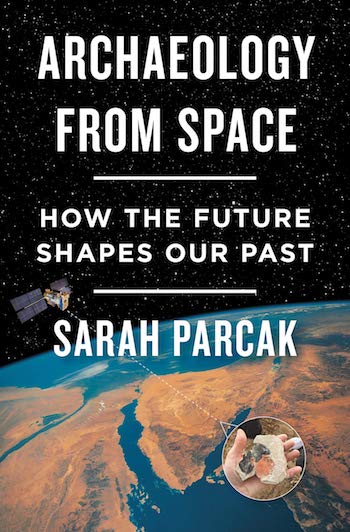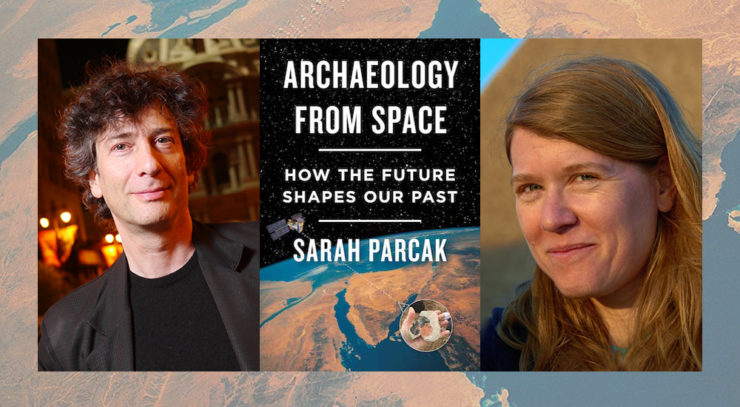It is a privileged few humans that get to see the Earth from space, that get to observe our planet in its most blue-marbley of forms. Archaeologist Sarah Parcak is one such human.
As a pioneer in the field of Space Archaeology, Parcak uses satellite imagery and algorithms to detect subtle clues that indicate things buried underground. She believes that archaeology helps us evolve as a culture, and that discovering new information about our past “will do nothing less than unlock the full potential of our existence.” Parcak and her team are uncovering lost artifacts, buried heroes, and discovering tools that help us rethink what we know about humanity on Earth.
But what happens when we start thinking beyond Earth? Would the same archaeological principals apply if we looked at alien civilizations, if we discovered evidence of life on another planet?
Neil Gaiman talked with Sarah Parcak about her work, what we have yet to discover, and the possibility of life beyond earth.
Gaiman: What have you learned about the past from looking at the earth from above?
Parcack: More than anything, I’ve come to realize that evidence for us—for our ancestors—is everywhere, and especially in the places we wouldn’t even think of looking. The people that came before us contained multitudes. Everywhere we look from above, we find hundreds or thousands or even tens of thousands of previously unmapped ancient sites. The past is a puzzle missing most of its pieces, and all these “new” sites allow us to—at the very least—build the puzzle’s outline. I’ve been lucky enough to collaborate on remote sensing projects spanning four continents, and I never know quite what we’ll find when we start working. I think what satellite imagery has taught me is just how vulnerable settlements can be to environmental changes. I see how small they are in comparison to the landscapes or rivers or natural features surrounding them, and it makes me root for these communities, even though I know the sites have long been abandoned.
Gaiman: How much Amazing Archeological Stuff do we know is waiting for us? I know we still have the First Emperor’s tomb waiting but are there more things that we know are out there we haven’t looked at yet?
Parcack: Every week in the headlines we read about Amazing Archaeological Stuff—just this week I’ve read about a new temple of Ptolemy IV in Egypt, the earliest evidence of baby “bottles” (ceramic vessels) in Turkey that likely led to a population boom in the Neolithic, and a “new” Canaanite city in Israel. Who knows what this week will bring…it’s what I love about my field. I say in my book that there are likely tens of millions of unmapped archaeological sites across the world, and I stand by that, at least until one of my colleagues decides to pull my argument to pieces in a journal article (please be nice to me). We know there are undiscovered royal tombs from a number of kings and queens from ancient Egypt, tombs like that of Genghis Khan in Mongolia, and of course numerous cities mentioned in ancient records that have simply disappeared today. With technology quickly advancing, and especially with the use of drone mapping, we’re able to map more at faster rates.
Buy the Book


Archaeology From Space: How the Future Shapes Our Past
Gaiman: In what ways do you think what we’ve learned about looking at the Earth to reveal its history could change the ways we think about the past?
Parcack: We have this persistent perception that people who lived hundreds or many thousands of years ago were completely unlike us. I find that laughable. While they might have spoken different languages, danced different dances, or eaten different foods, I assure you that you would find them exactly like us—happy, silly, stressed, worried, in love, sad, moody, making things, and above all dreaming of a better world. The creativity and inventiveness they showed would rival or surpass any maker today—I mean, these are people who literally invented sliced bread (14,400 years ago in Jordan to be precise) and the written word (debated, but ca. 5000 years ago in Egypt and Mesopotamia). Studying the past increases our ability to be empathetic. I just read about a cuneiform tablet from 3,000 years ago from Ashur that described depression. It forced me to remove myself from today and put myself in the shoes of someone from a long time ago, and made me feel like a small part in the long arc of the suffering and joy of humanity. Finding all these “new” sites from above has allowed us to imagine the past at a bigger scale, and, at least for me, makes it feel more present and connected to our modern world. The stories we get from an excavation makes this feeling even stronger.
Gaiman: Have you ever dreamed about looking at another world and using space archaeology to learn about it? And, if you were in space and looking for signs of ancient civilizations, what would you search for?
Parcack: All the time! In fact, I think this is one of the great failings of NASA’s astronaut program…that you need to have a Bachelor of Science to apply. You get a BA when you study archaeology, which means that I could never be an Astronaut. What happens when someday, as I believe we are bound to do, we find evidence of civilizations on other worlds? NASA, Elon Musk, Jeff Bezos, if you are reading this, call me. You need me. You need us.
Now, these future civilizations could be underwater cities built by Octopi—beings, or they could be giant floating brightly colored pods suspended thousands of feet above the ground for feather-beings…but they will be likely be distinguishable from the landscapes or seascapes surrounding them, in clear shapes. My entire academic career is based on finding shapes and then playing in the dirt (I never left Kindergarten). NASA’s astronauts are not trained presently to find archaeological sites, and as far as I’m aware, it’s not part of their plans for exploring other worlds. Here’s the important thing: no matter what we find on other planets, even if the civilizations are long gone, and totally unlike anything on our world, we archaeologists already have established systems and frameworks for finding, mapping, excavating, and processing data from diverse cultures. My book chapter on “The Future of the Past” speaks about this exact issue. I think we have to start preparing now for what civilizations on other worlds might look like.
Gaiman: What’s surprised you most about the past that you wouldn’t have known without the technology we have today?
Parcack: For me, it’s the size and extent of diverse past civilizations. We take for granted just how expansive these civilizations were, and even the scale of sites that seem large on the ground, but we can only see a small part of the sites because they are obscured by vegetation. I’m thinking of the site of Tikal in Guatemala, which everyone knows because it was featured as the rebel base on Yavin 4 in Star Wars: A New Hope. Laser mapping technology, called LIDAR, revealed over 60,000 previously unmapped structures at just that one site, which is in the middle of the rainforest. Archaeologists used the same technology to map the famous site of Angkor Wat, which showed the housing of the countless people who would have helped to run the temples. There are so many questions about how and why ancient civilizations rose and collapsed—or collapsed in part. New technologies allow us to see more, and with that evidence, ask more refined questions about the past, like what ecological factors might have played a role in helping a civilization grow.
Gaiman: Are there any science fiction books or media properties that you think get it right in terms of archaeology?
Parcack: Whew, this is a tough one. For movies, The English Patient captures the camaraderie and excitement of an archaeological expedition. For sci-fi novels, I think NK Jemisin’s Stone Sky series does a brilliant job of imagining ruins. Those books evoked very strong feelings for me thinking what our future world might look like to people way, way ahead of us looking back. I’ve just finished Philip Pullman’s new book The Secret Commonwealth and (no spoilers don’t worry!) there is a part where he really captures what an old and abandoned place feels like. I loved writing in my book about what archaeology is like in 3019…I’m tempted to write a sci-fi archaeology book now.
Sarah Parcak is the author of Archaeology from Space: How the Future Shapes Our Past, and a Professor of Anthropology at the University of Alabama at Birmingham. She’s President and Founder of Globalxplorer, Director of the Joint Mission to Lisht (Egypt), and a National Geographic Explorer. Her remote sensing work has been the focus of three BBC specials covering Egypt, ancient Rome, and the Vikings, and she won the 2016 TED Prize.
Neil Gaiman is the author of the New York Times Bestselling The Ocean at the End of the Lane, American Gods, Neverwhere, and the Sandman series of graphic novels, among other works. His fiction has received Newbery, Carnegie, Hugo, Nebula, World Fantasy and Will Eisner awards. Originally from England, he lives in the United States, where he is a professor at Bard College.










